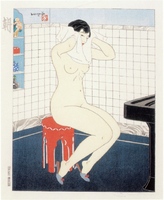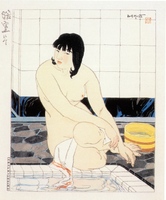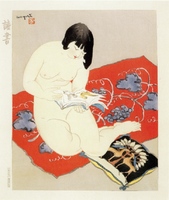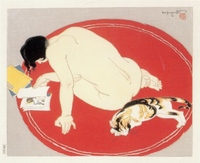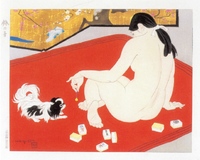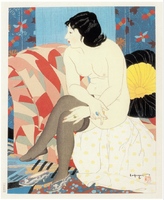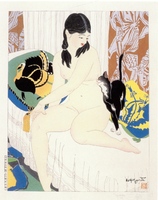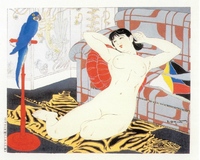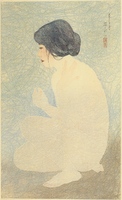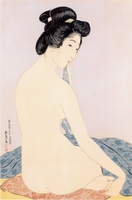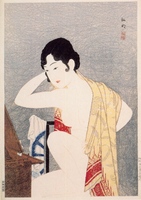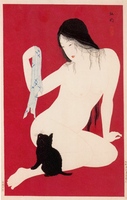Japanese Modernism Across Media
Visual Essay
‘Ten Types of Female Nudes’
Through the introduction of the overall exhibit, as well as introductions to each subsection, I have encouraged the viewer to look at the selected images with a keen eye for marks of modernity. There is no doubt that these shin hanga images are stylistically quite different from their predecessor ukiyo-e prints. However, the contemporary indicators in “Modern beauties” are more nuanced in that they lie in the artistic styles and methods of the prints rather than the depiction of the women in these prints. The females of the “Moga” section provide a stark contrast to the demure, angelic women of the “modern beauties.” The moga is bold and daring, with her permed and/or bobbed hair, made up face and bejeweled self. The nude was a relatively new subject in high Japanese art. Just her presence in these prints is an indicator of the country’s desire to master, not just the technology of Western countries, but also their culture. Although the existence of these prints is evidence of the nude’s acceptance as subject matter, its form came as a compromise, where most depictions of the nude figure were limited to the activities surrounding her toiletries or bathing. [1] I argue that Ishikawa Toraji’s sole foray into prints of the female image, the series of ‘Ten Types of Female Nudes’ completed in 1935, pushes well past the bounds of the portrayal of the female image in shin hanga, making it uniquely modern. More specifically I contend that ‘Ten Types of Female Nudes’ embodies/displays most, if not all the different ways in which modernity is demonstrated in the shin hanga prints of the female image in this exhibit.
As already indicated, the depiction of the nude in Japanese shin hanga prints is limited largely to women attending to their toiletries or in some manner of bathing. These limited settings result in a greatly romanticized and objectified presentation of the female. This brings us to one of the ways in which Toraji’s series of ‘Ten Types of Female Nudes’ is different. To begin, all but one[2] of the nudes by artists other than Toraji in this exhibit depict women attending to their toiletries or in some manner bathing. In short, the female nude is limited nearly exclusively to these two actions; however Toraji seems to see no reason to work within these accepted constraints. Instead, of the ten prints in Toraji’s nude series, only two depict the nude figures in bathing scenes (Figures 1 and 2). Of the remaining eight nudes in the series, seven prints depict the nude figure within various areas of the domicile. Of these seven prints depicting the nude at home, only one print is slightly reminiscent of the restricted image of the nude figure attending her toiletries (Figure 3), but that interpretation is somewhat overstated, as this figure is standing in front of a full mirror attached to a dresser. Although the figure holds a comb in her right hand, the artist has decided not to capture the moment that she is combing her hair (which seems to have been a very popular subject choice), [3] but instead catches her gazing at her reflection in the mirror. In the remaining six prints of the nude figure depicted at home, the figure is depicted in a variety of positions. More specifically, in Reading (Figure 4), the nude figure sits on a rug while reading a book; in Bored (Figure 5), the figure is sprawled out on a red oval shaped carpet while flipping through a few magazines; in Tinkle of a Bell (Figure 6), the figure is sitting on a carpet playing with a small dog; in Relaxing (Figure 7), the nude is looking pensive while smoking and sitting on a chaise; and in Black Cat (Figure 8), the figure is sitting on a bed while petting a cat . The last in this group of seven domestic images is Blue Parrot (Figure 9), in which the nude is sitting on the floor and leaning against a couch while looking at a parrot . The tenth and final image depicts the nude figure as a dancer performing on a stage (Figure 10), a complete departure from the preceding nine prints.
The diverse settings depicted in Toraji series of ‘Ten Types of Female Nude’ is just one example of the way in which Toraji’s nudes are uniquely modern within the context of shin hanga prints. One very interesting facet of the portrayal of the female image in shin hanga prints is how infrequently the setting itself is depicted in much detail. As an example, the nude figure in Itō Shinsui’s Bathing in Early Summer (Figure 11) is depicted in a hazy mist due to the warm and moist air of the bathing room. Only the subtle melding of the blue background into brown at the bottom part of the page distinguishes the wall from the floor. The viewer understands that the figure is in a bathhouse, solely because of her state of undress and the title of the print. The lack of detail allows the picture to have a more romanticized view of the woman, making her an object to be consumed.
The above observation can also be applied to prints of other nudes such as Hashiguchi Goyō’s Woman after Bath (Figure 12). Through a combination of differences in color and texture, the artist has made a clear distinction between the wall and the floor. In addition, it is made clear that the nude figure is sitting on a pillow and is using a piece of material to dry herself, but the viewer still has no visual cues to indicate what sort of room is being depicted. Another example from outside the bathing house context is with the print of a modern beauty, A Pair of Japanese Socks by Narita Morikane (Figure 13). In this print, the floor and the wall are the same color. Only the piece of fabric behind the figure provides a visual cue as to where the floor ends and the wall begins. It is difficult to understand the exact purpose of the fabric lying behind the figure. If it were possible to state that it was a bed cover, the viewer would be able to assume that the figure is sitting in a bedroom. As this is not the case, the viewer is not able to determine specifics about the room or the setting of the subject.
In contrast, most of the nudes in Toraji’s series have very lushly detailed settings. Unlike the other prints of females in shin hanga prints, in his images Toraji has included multiple pieces of furniture and wall decorations, many of which are Western-influenced. For example, seven of the ten prints in the series have multiple pieces of furniture, five of which are in the domicile. In Blue Parrot (Figure 9), the nude figure is sitting on a tiger print rug and leaning against a couch covered with multiple pillows and there is a white screen with a plant design on it placed in the top left corner of the image. In addition to the rug on which the figure sits in Tinkle of the Bell (Figure 6), the bottom edges of a gilded and painted screen peak out at the top of the image. In Spring Time of Life (Figure 3) the nude figure is standing in front a long mirror sitting on top of a dresser. The wall to her left is brightly papered, while a colorful curtain and a cushioned seat are positioned behind her. In addition, a parrot is sitting on a bright red stand. The figure in Black Cat (Figure 8) is sitting on a bed that has numerous pillows. The other surfaces in the room are also decorated, with the floor brightly carpeted and the window having draperies. In Relaxing (Figure 7), a brightly patterned chaise with a large pillow is depicted in great detail. Similar to Black Cat, the floor is carpeted and the windows have lush draperies.
There is no doubt that the five images described are important because they are not only heavily furnished, but all of these women are partaking in activities unrelated to their toiletries or other state of bathing. However, the fact that two images in the series are of nudes bathing but are also heavily furnished is particularly significant. In Morning (Figure 1), the figure is sitting on a six-legged bright red stool. She is drying off her hair with a white towel while her head is slightly turned toward the viewer. Similar to the other five prints already described, the setting is depicted in incredible detail. For example, the deep blue color of the flooring contrasts sharply against the square white colored tile. The baseboard, as well as the top trim of the tiling, is a marbled gray. The tiling does not go up the entire wall and the wall is painted a light blue-gray above the tiles. On the wall behind the nude figure is a built-in shelving unit. There are four shelves and on each shelf there are different kinds of knickknacks (such as a small vase, a box, a jar and a flower arrangement), each in a different color. In front of the nude figure is a black pedestal sink.
In addition to the subjects of the female nudes in shin hanga being limited to women applying toiletries or bathing, a large number of the prints produced within each of the categories are also quite similar in nature. In part, that is what makes the nudes in Toraji’s series so impressive; all of the figures, including the two prints of women bathing, are quite different from one other. In At the Bath (Figure 2), the nude figure is sitting on her knees leaning to her right. Her head is also cocked to the right and she has a towel laid across her upper thighs. The towel is almost falling into the pool. Toraji even displays the reflection of the figure and the towel in the bathing pool. The floor is a very convincing mix of stones, detailed to the point of having the grout visible. The wall behind the nude figure is decorated with vertical rectangles of white tile. The baseboard is a marbled black, blue and grey pattern. To the figure’s left is a yellow bucket. In short, the bold and clear lines and details of At the Bath (Figure 2) bear little resemblance to the hazy images of Ito Shinshui’s bathing women in Bathing in Early Summer (Figure 11).
With regard to furnishings, in a similar manner to the other prints of the female image in shin hanga, three of Toraji’s prints lack furniture. In Reading (Figure 4), the figure is sitting on her knees and flipping through a book. Like many of the other prints in this exhibit, there is no color difference between the wall and the floor. However, the floor is distinguished in part because the figure is sitting on a bright red carpet with a grey blue grape leaf design. The figure’s left knee is resting on a pillow on which are depicted a tree and two deer facing each other. So although there are only two furnishings in this print, they are presented in great detail.
The second of the remaining three images is also an image of a nude figure reading. In Bored (Figure 5) the nude is sitting on her knees but is bent over flipping through some magazines or pamphlets. As in Reading, the rug is the sole demarcation of where the wall ends and the floor begins. The woman’s body takes up most of the oval red rug on which she sits. Stretched out behind her is a calico cat. However, this image is unique compared to other images in this series as its perspective is unusually poor.
The last image of this remaining group of three is the print titled Dance (Figure 10). In addition to this particular print being an outlier in this series, it is also a bit of an outlier within this final set of three prints. The nude is posed on a stage with her back to the viewer, her arms extended towards the stage curtains with her head turned towards the audience. As the nude figure is on the stage, the spot light casts an eerie yellow-greenish light on her. The piece is interesting, as like the two prints just mentioned, there are very few furnishings. The stage floor and the curtain are clearly demarcated by color (the stage floor being red while the curtain is black). However, the lack of furnishing would make sense as neither stage curtains nor stage floors tend to have significant amounts of additional furnishings. The only scenario in which that might not be the case would be if the performer had props. But since the show seems to require strutting across the stage nude, then the dancer would most likely not have any props. However, Toraji, has cleverly found a way to add some texture and detail to the figure without obscuring and obstructing the figure’s nudity. He has done this by adding visual interest to the print by providing the nude dancer with a fishnet scarf encircling her back and with its ends then coming around and draping over her arms.
We have discussed the general presence of furniture in the prints of Toraji’s series of ‘Ten Types Female of Nudes,’ however, we have yet to discuss in more detail the significance of the stylistic aspects of the furniture. As just discussed, furnishings are strewn throughout the prints in ‘Ten Types of Female Nudes.’ As alluded to earlier in this paper, many, if not all, of the objects included in these images are influenced by Western furnishings. For example in Spring Time of Life (Figure 3), the small stool behind the standing figure is upholstered in a Western style. Another example can be found in Blue Parrot (Figure 9). The nude figure is sitting on the floor in front of a couch. Traditionally, Japanese lived a floor level life-style which resulted in a lack of need to create raised furniture for seating and reclining.[4] Therefore the presence of Western style furniture (i.e. a couch) is another sign of Western influences. The same observation applies to the chaise in Relaxing (Figure 7). It is important to note that depicting the settings as more Western could make the prints more understandable and accessible to the Western viewer. Thus with little or no knowledge of the appearance of typical Japanese furniture or the context in which it might be found, the Western viewer could associate the furniture with particular rooms familiar to him/her.
In addition to the furniture in these prints, there are also other objects that are indicators of modernity. For example, in Spring Time of Life (Figure 3), a doll sits on the dresser. However, this is not a doll dressed in traditional Japanese clothing; instead it is clothed in a Western-style white dress. The figure wears a blue and white striped apron over the dress and is also wearing a bonnet. Another sign of modernism is the presence of the magazines in Bored (Figure 5) as well as the book the nude figure is perusing in Reading (Figure 4). This connection my not seem obvious, but, as in many countries, books and leisure reading material were not accessible to all levels of Japanese society at this time. Usually only the richest families could afford the hand written literature. The print revolution in Japan began when the new printing technology was imported into the country in the late 1800s,[5] making it possible for nearly everyone to afford buying books and magazines. Therefore, although we do not know the social status of the women depicted in Toraji’s ‘Ten Types of Female Nudes,’ the presence of the reading material demonstrates the more typical access to printed literature the general population would have attained by this point.
Thus far we have talked about the objects within these prints, the furniture, the setting and the fabric. However, we have yet to discuss the nude figures themselves. As aforementioned, their nudity is a sign of modernity in general. However, there are other physical characteristics of these figures that are also demonstrations of modernism. The first example is the ruby red lips of the nude figures throughout this series of prints, a clear indication that it was socially acceptable for women to wear make-up. In addition the nude in Relaxing (Figure 7) is smoking a cigarette. Although men smoked, traditionally it was not socially acceptable for women to do so. The fact that the nude is smoking a cigarette is another sign of contemporaneousness. Cigarettes were one of the many Western fashions to be imported into the country in the beginning of the Meiji Era (1868-1910).[6] Relaxing is also modern in perspective as the nude is wearing a few pieces of jewelry, something not common in earlier prints.
However, the most obvious marker of modernity for these figures is their hairstyles. Hairstyles were greatly regulated and restricted by the government; Japanese women were not allowed to cut their hair. [7] In all of the prints in ‘Ten Types of Female Nudes,’ the hair is either quite short or significantly shorter than was traditionally acceptable. However, the two boldest styles are the permed hair and the bob. Although both of these hairstyles were strong statements of modernism, the bob was the bolder of the two and the more controversial. For example, a woman could be disowned and have all ties severed by her family for having a bob haircut.[8]
Other than in Toraji’s prints, very few nude figures tended to have the shorter and/or permed hairstyles. In fact, in the collection selected for this exhibit, only two, Takahashi Hiroaki’s Make-up Before the Mirror (Figure 14) and Natori Shunsen’s After a Bath (Figure 15),picture the nude figure with permed hair. On the other hand, these hairstyles were a defining feature of the moga. As Kendall Brown and Sharon Minichiello wrote with regard to the moga, “The permanent wave, the short, curled hair style that was the most basic symbol of modern femininity.” [9] By giving his female nudes contemporary hairstyles and having them wear jewelry and make-up, Toraji has combined the moga with the nude in this series of prints.
Lastly, we must address the artistic techniques and approaches that make this series of nudes particularly modern. Unlike most of the artists included in this exhibit, Toraji, primarily a painter, was taught in the Western style painting. His formal art teacher was the Western-style painter Koyama Shotaro (1857-1916). Like many other yoga (Western painting style) artists in the early 1900s, Toraji traveled throughout Europe and America to further develop his Western painting technique. [10] As Alan Hockley writes regarding the figure’s position in At the Bath (Figure 2), “He captures the careful balance of the body’s large masses required by this pose and, in the process, foreshortens both legs.” [11] This image contrasts sharply against the flatness in Torii Kotondo’s Combing the Hair (Figure 16), Shinshui’s Bathing in Early Summer (Figure 11) and Hiroaki’s Nude Playing with Cat (Figure 17). However, At the Bath is not the sole of example of this technique as most of the images in this series also bear this mark of Toraji’s Western-style training. In short, these images are considered modern not only for the objects and figures they depict, but also for the style and manner in which they were rendered.
I have walked you through the various ways in which this series of nudes is modern, from the subject matter, to the settings, to the objects, and finally to the artist’s techniques. Although there are several prints included from as late as the early 1950s, with their 1935 publishing date, ‘Ten Types of Female Nudes’ are placed towards the latter half of the prints displayed in this exhibit. By this time, Toraji had the time to absorb his Western-style training and tendencies and then implement them in these prints. However, there are a number of prints by other artists from the early 1930s that still look quite similar to prints made at the turn of the nineteenth century. Therefore, regardless of timing, Toraji created a series of nudes that stand out from the other 20th century nudes in this exhibit and indeed from the images of the female figure in shin hanga prints in general.
[1] Chris Uhlenbeck, Maureen De Vries, and Elise Wessels, Emerging from the Bath: The Nude in 20th Century Japanese Prints (Amsterdam: Nihon No Hanga, 2010), 15.
[2] Takahashi Hiroaki’s Nude Playing with Cat
[3] Such as: Hashiguchi Goyō’s Woman Combing Her Hair & After Washing Her Hair, Torii Kontondo’s Combing Her Hair & Combing Hair, Natori Shunsen’s Combing Her Hair, Kobayakawa Kiyoshi’s Glossy Dark Hair, and Narita Morikane’s Combing Her Hair
[4] Kazuko Koizumi, Traditional Japanese Furniture (Tokyo: Kodansha International, 1986), 11.
[5] Koichi Kabayama, “The Age of the Magazine: From Citizen to Nation” The Birth of a Million Seller: Magazines as Media in Meiji and Taishō Japan (2008), pp. 1-25
[6] Daniel Gilman, "Smoking in Modern Japan," in Smoke: A Global History of Smoking, ed. Sander L. Gilman and Zhou Xun (London: Reaktion Books, 2004), 174.
[7] Chris Uhlenbeck, Maureen De Vries, and Elise Wessels, Feminine and Independent: The Modern Women of Pre-war Japan (Amsterdam: Nihon No Hanga, 2011), 21.
[8] Uhlenbeck et al, Feminine and Independent, 23.
[9] Kendall H. Brown and Sharon Minichiello, Taishō Chic: Japanese Modernity, Nostalgia, and Deco (Honolulu: Honolulu Academy of Arts, 2001), 20.
[10] Kendall H. Brown, Nozomi Naoi, and Allen Hockley, The Women of Shin Hanga: The Judith and Joseph Barker Collection of Japanese Prints, ed. Allen Hockley (Hanover, NH: Hood Museum of Art, 2013), 117.
[11] Brown et al, The Women of Shin Hanga, 234
